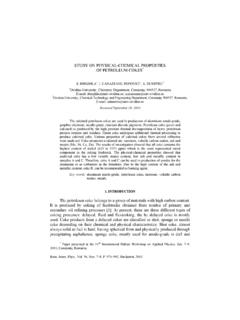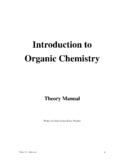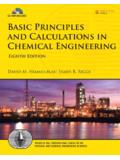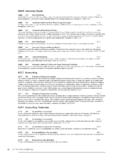Transcription of GUIDANCE FOR ASSESSING PETROLEUM …
1 Number: DERR-00-DI-033 ISSUED: 4/14/04 (4/2/10 update) STATUS: Final PAGE: 1 of 15 UPDATE: 2010 GUIDANCE FOR ASSESSING PETROLEUM HYDROCARBONS IN SOIL PURPOSE: To assist regulators and responsi ble partie s in assessi ng the risk from soil impacted by PETROLEUM hydrocarbons at remedial response sites. KEY WORDS: PETROLEUM hydrocarbons; soil; Total PETROLEUM hydrocarbons (TPH); gasoline; diesel; oil; light PETROLEUM fractions; mi ddle PETROLEUM fracti ons; heavy PETROLEUM fractions BACKGROUND: Oh io EPA-DERR addresses sites contaminated by PETROLEUM hydrocarbons as a result of spills (emergency response and post- response activities), as co-contaminants a t hazardous waste and CERCLA sites, as water poll ution abatement actions under ORC 6111, and as Voluntary Actions under ORC 3746 and OAC 3745-300.
2 Evaluati on a nd remediation of PETROLEUM hydrocarbon sit es is d ifficult, owing to the complex regulatory and technical c ha llenge s associated with eval uati ng such sites. This GUIDANCE document was developed to assist both the regulators and responsi bl e par ties in assessi ng the risk from soil impacted by PETROLEUM hydrocarbons. T he gui dance document is part of the overall assessment of risk at the sit e, and is meant to be used in conjunction with the available regulations and other appropriate risk assessment GUIDANCE . Th is guid ance presents a risk-base d approach for the assessment of so il im pacted by PETROLEUM hydrocarbons.
3 This approach includes the evaluati on of indicator chemicals and residual PETROLEUM constituents. Necessary inputs to ca lcula te human health risk- based numerical standards, such as physicochemical and toxicity data, are provided. Ana lytic al samplin g req uirements necessary for site assessment are also provided to ensure that sample results are compati ble w ith the proposed risk assessment process. The GUIDANCE does not address PETROLEUM hydrocarbons leaching to ground water. If leaching from so il impacted by PETROLEUM hydrocarbons to ground water is a concern at the site, refer to the DERR Total PETROLEUM Hydrocarbons (TPH) l eaching GUIDANCE .
4 Also, in a sp ill sit ua tion w here an immediate response is nee ded to address t he release, it is ex pected that the PETROLEUM Contaminat ed Sites GUIDANCE Document f or Eme rgency Response Actions (ER-013, March 2005) will be the protocol follow ed. Number: DERR-00-DI-033 ISSUED: 4/14/04 (4/2/10 update) STATUS: Final PAGE: 2 of 15 UPDATE: 2010 DISCUSSION: In Ohio, as in m any other areas of the country, PETROLEUM hydrocarbon contaminati on i s wi despread. C ontaminati on results from m isha ndling, spilling, or leaki ng products, in cluding gasoline , motor and lubricating o ils, diesel fue l, hea ting o ils and aircraft f uels.
5 Each of these PETROLEUM products are complex mixtures containing hundreds to thousands of differ ent chemical compounds. Vari ous PETROLEUM products may also contain additi ves. Th e diverse chemical compou nds exhibit a la rge r ange of behavior in envir onmental media governed by their physicochemical pr operties. As a result o f these characteristics, the assessment of risk from ex posure to PETROLEUM hydrocarbon mixtures is diff icult. In the environment these mixtures can change through weat hering (that ma y i nclude vola til iza tion, biodegradati on, par tit ioning, oxidati on, photo-degradation, etc.)
6 , furth er complicating t he determination of risk from exposure. The more s ol uble or volatile compounds will migrate to ot her location s. The mostly non-mobile components are left behind at the release sit e. A s a result, the receptors can be exposed to a different mixture than that originally rel eased to the envir onment. Factors including location o f rel ease, length of time between the release and exposure, media of ex posure, etc. ca n all c ontribute to t hese differ ences. Oh io EPA-DERR has developed a tiered appr oach to assess the risk presented by PETROLEUM contamination in so ils as discussed below.
7 Information from the Total PETROLEUM Hydrocarbon Criter ia W orking Group (TPHCWG), as well as that available from states, includin g Massachusetts and Lou isi ana, were use d t o develop this gui dance. Th e TPHCWG is a national workgroup comprised of representatives from federal and state agencies, i ndustry and academia . The group was formed to a ddress the disparity among cleanup requirements at sites contaminated with hydrocarbon materials, and develop sci entif ically defensible soil cl ean up levels. If l eaching from soil im pacted by PETROLEUM hydrocarbons is a concern at a site, refer ence should also be made to the DERR Soil Leaching to Ground water Eval uati on for Total PETROLEUM Hydrocarbons (TP H) Gui dan ce (RR- 036, January 14, 2004).
8 Tier 1: (1) The analysis and assessment of indivi dual PETROLEUM -related compounds (indicator compounds) using c hem ical-specific tox icity criter ia and physicochemical properties and (2 ) t he analysis fo r t ota l PETROLEUM hydrocarbons (TPH) oil, gasoline and diesel ranges and (3 ) Total TPH s hould not exceed soil s atura tion concentrations. Tier 2: (1) The analysis and assessment of indivi dual PETROLEUM -related compounds (indicator compounds) using c hem ical-specific tox icity criter ia and physicochemical properties and Number: DERR-00-DI-033 ISSUED: 4/14/04 (4/2/10 update) STATUS: Final PAGE: 3 of 15 UPDATE: 2010 (2 ) TPH fractions using fracti on-specific t ox icity cr iter ia and physio-chemical pr oper ties and (3) Total TPH should not exceed soil satu ration concentrations.
9 I t should b e noted t hat th e de cisi on t o assess petrol eum contamination by t he methods provided in Tier 2 is not a requirement of the proposed process. Tier 2 is op tional and it is provided for t hose situati ons where greater sit e-specific st udy is desi red and warrant ed. Each Tier documents the assessment process, determinati on of human health e ffects of che micals of concern, and relevant physicochemical and tox ici ty values. Once t he inputs to the risk assessment have bee n developed per these guidelines, these PETROLEUM constituents are to be t aken through the human health risk assessment procedures.
10 The DERR Ecological Risk Assessment gui dance document should be consulted for appr opria te ecological-specific assessment procedures. Tier 1: Analysis of Indicator Compounds a nd TPH In Tie r 1, the evaluati on of PETROLEUM -impacted soil i ncludes the assessment of: (1) I ndivi dual PETROLEUM -related compounds (indicators) using chemical-specific toxicity criter ia and physicochemical properties, and (2 ) Tota l PETROLEUM hydrocarbons (TPH) (TPH-gasoline r ange o rganics (G), TPH- diesel range o rganics (D), and/o r T PH-o il ra nge organics (O)) and (3) Evaluate TPH soil saturation concentra tions.












